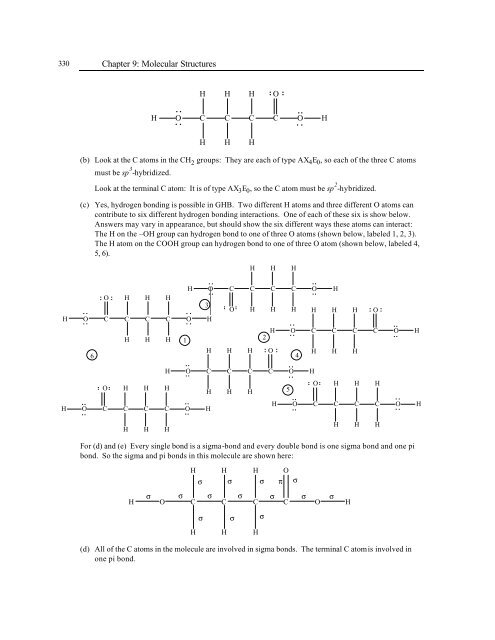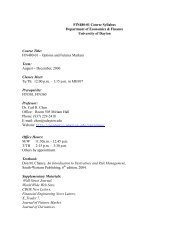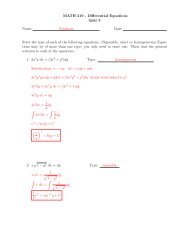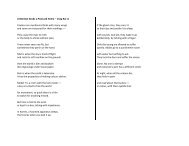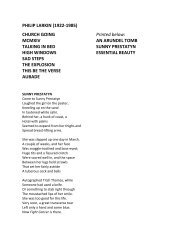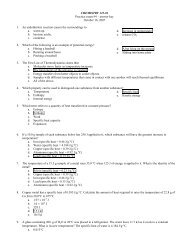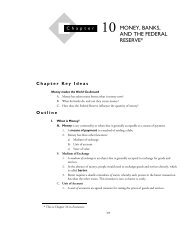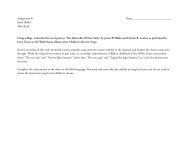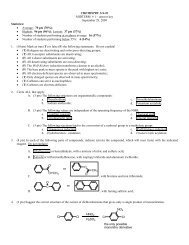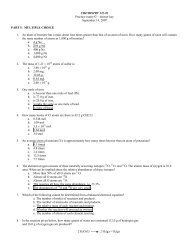Chapter 9 - University of Dayton Academic Webserver
Chapter 9 - University of Dayton Academic Webserver
Chapter 9 - University of Dayton Academic Webserver
Create successful ePaper yourself
Turn your PDF publications into a flip-book with our unique Google optimized e-Paper software.
330<br />
H<br />
H<br />
<strong>Chapter</strong> 9: Molecular Structures<br />
H<br />
H H H O<br />
. .<br />
. . . . . . .<br />
.<br />
O C C C C O H<br />
H<br />
H<br />
(b) Look at the C atoms in the CH 2 groups: They are each <strong>of</strong> type AX 4E 0, so each <strong>of</strong> the three C atoms<br />
must be sp 3 -hybridized.<br />
Look at the terminal C atom: It is <strong>of</strong> type AX 3E 0, so the C atom must be sp 2 -hybridized.<br />
H<br />
(c) Yes, hydrogen bonding is possible in GHB. Two different H atoms and three different O atoms can<br />
contribute to six different hydrogen bonding interactions. One <strong>of</strong> each <strong>of</strong> these six is show below.<br />
Answers may vary in appearance, but should show the six different ways these atoms can interact:<br />
The H on the –OH group can hydrogen bond to one <strong>of</strong> three O atoms (shown below, labeled 1, 2, 3).<br />
The H atom on the COOH group can hydrogen bond to one <strong>of</strong> three O atom (shown below, labeled 4,<br />
5, 6).<br />
..<br />
. O.<br />
..<br />
O<br />
. .<br />
6<br />
.<br />
.<br />
O<br />
C<br />
O<br />
C<br />
.<br />
.<br />
H<br />
C<br />
H<br />
H<br />
C<br />
H<br />
H<br />
C<br />
H<br />
H<br />
C<br />
H<br />
H<br />
C<br />
H<br />
H<br />
H<br />
C<br />
H<br />
..<br />
. O.<br />
1<br />
H<br />
H<br />
H<br />
H<br />
2<br />
. O .<br />
O C C C C O H<br />
H<br />
H<br />
. . . . . . . .<br />
..<br />
O . .<br />
. .<br />
O..<br />
3<br />
H<br />
.<br />
C<br />
O<br />
H<br />
.<br />
H<br />
H<br />
H<br />
H<br />
. O .<br />
O C C C C O H<br />
H<br />
H<br />
. . . . . . . .<br />
For (d) and (e) Every single bond is a sigma-bond and every double bond is one sigma bond and one pi<br />
bond. So the sigma and pi bonds in this molecule are shown here:<br />
H<br />
H<br />
σ σ σ σ σ σ σ<br />
O C C C C O H<br />
H<br />
σ<br />
σ<br />
H<br />
H<br />
σ<br />
σ<br />
(d) All <strong>of</strong> the C atoms in the molecule are involved in sigma bonds. The terminal C atom is involved in<br />
one pi bond.<br />
H<br />
C<br />
H<br />
H<br />
σ<br />
H<br />
σ<br />
H<br />
C<br />
H<br />
π<br />
5<br />
O<br />
H<br />
C<br />
H<br />
4<br />
..<br />
O<br />
. .<br />
σ<br />
.<br />
. .<br />
O..<br />
O<br />
C<br />
.<br />
H<br />
H<br />
H<br />
C<br />
H<br />
H<br />
H<br />
H<br />
C<br />
H<br />
H<br />
C<br />
H<br />
..<br />
O . .<br />
H


